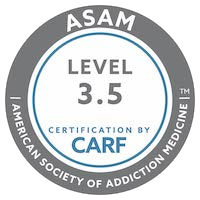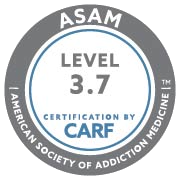If you or a loved one is contemplating seeking addiction treatment, rest assured you are not alone and contact professionals for help and support. The prevalence of addiction in the United States is significant. Below, we delve into the statistics. We used data from the National Center for Drug Abuse Statistics (NSDUH) for analysis.
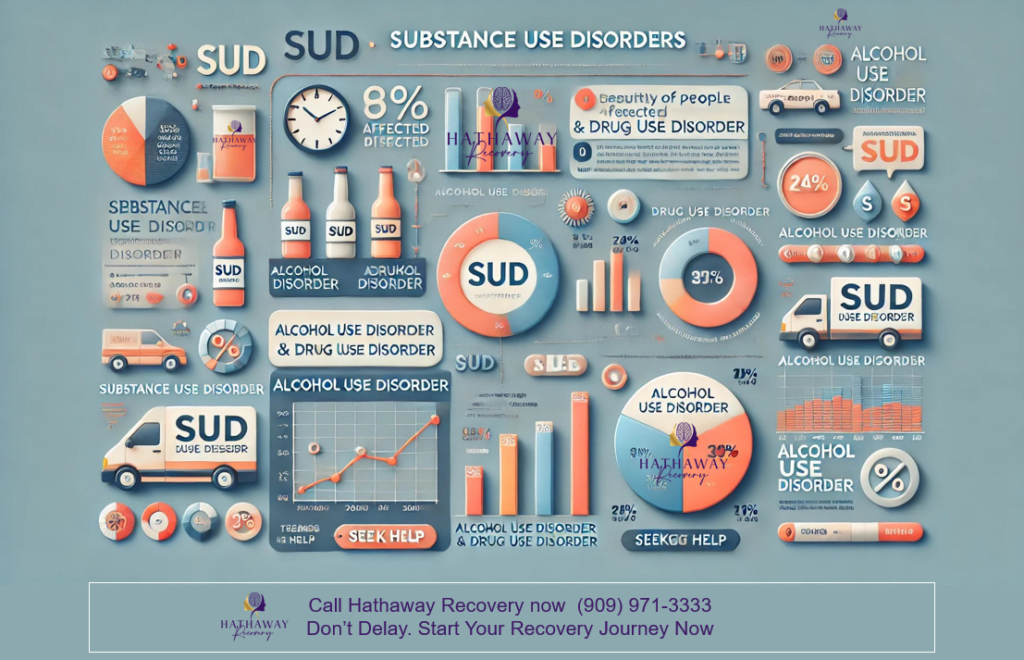
National Statistics (2022 NSDUH):
– 46.8 million (16.7%) Americans aged 12 and older experienced a substance use disorder last year.
– 10.5% of Americans aged 12 and older had an alcohol use disorder.
– 27.2 million Americans aged 12 or older (9.7%) reported having a drug use disorder.
– 8 million (2.9%) Americans aged 12 and older had both alcohol and drug use disorders.
– 21.5 million American adults (8.4%) struggled with both a mental health disorder and a substance use disorder (co-occurring disorders).
Root Causes of Addiction
– Genetics
– Environmental influences: Chaotic home life, parental drug use, peer influences, community drug attitudes, and poor academic performance.
– Teenagers and those with mental health disorders are more susceptible.
Demographic Breakdown of Drug Use
The bar chart titled “Substance Use Disorders by Age Group (2022)” illustrates the percentage of individuals within different age groups who experienced substance use disorders in 2022.
The age groups are divided into four categories: 12-17, 18-25, 26+, and 65+.
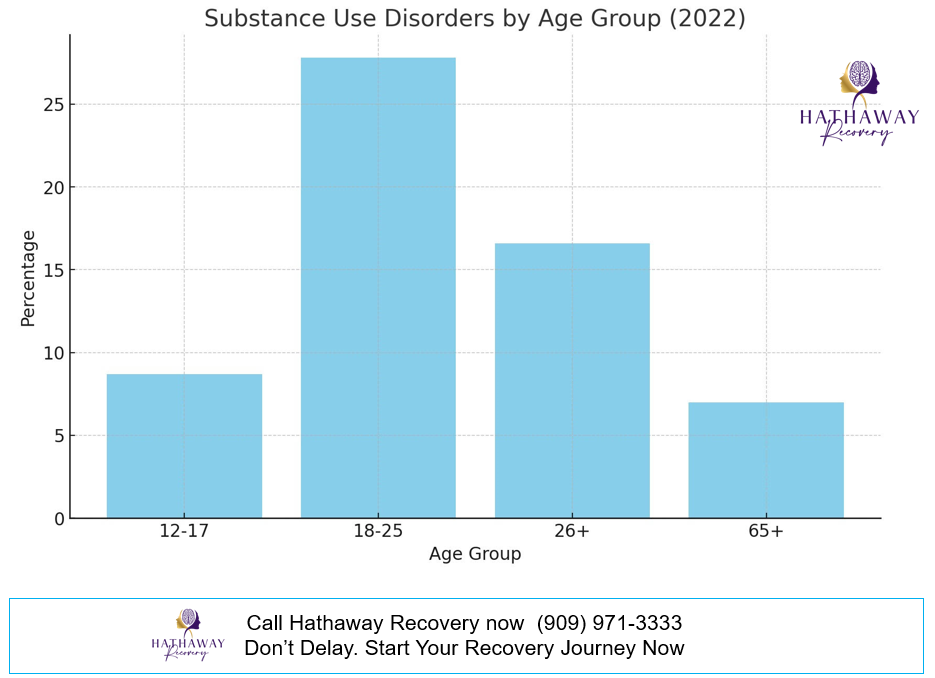
The chart shows:
– Adolescents aged 12-17 had an 8.7% prevalence of substance use disorders.
– Young adults aged 18-25 exhibited the highest prevalence at 27.8%.
– Adults aged 26 and older had a prevalence of 16.6%.
– Elderly individuals aged 65 and older had the lowest prevalence at 7%.
This chart highlights that young adults are the most affected age group, indicating a significant need for targeted interventions and support for this demographic.
Gender Differences
– 10.9% (15 million) males and 8.4% (12.1 million) females aged 12 and older had a substance use disorder.
– Men are more likely to use drugs, but women are equally prone to addiction when they do.
– Women in recovery are more susceptible to cravings and relapse and may develop opioid dependence more rapidly than men.
Ethnicity/Race
– 24% of American Indians and Alaska Natives
– 17.6% of White Americans
– 18.4% of African Americans
– 17.4% of Hispanics or Latinos
– 9% of Asian Americans Adequate data for Native Hawaiians and Pacific Islanders was not collected in 2022, but 20.7% experienced substance use disorder in 2021.
Employment and Criminal Justice
– 20.1% of full-time employed adults had a substance use disorder.
– 27.9% of unemployed adults had a substance use disorder.
– 63% of jail inmates and 58% of prison inmates met criteria for substance use disorder.
Veterans
– 15.8% (1 million) veterans aged 18 or older had a substance use disorder.
– 9.5% (8 million) had an alcohol use disorder.
– 7.7% (1.5 million) had a drug use disorder.
– Veterans aged 18-49 had higher rates of substance use disorder than those aged 50+.
Addiction to Specific Substances
We created a chart that shows the Proportion of Different Substance Use Disorders (2022). It visually represents the relative prevalence of different types of substance use disorders among Americans aged 12 and older in 2022.
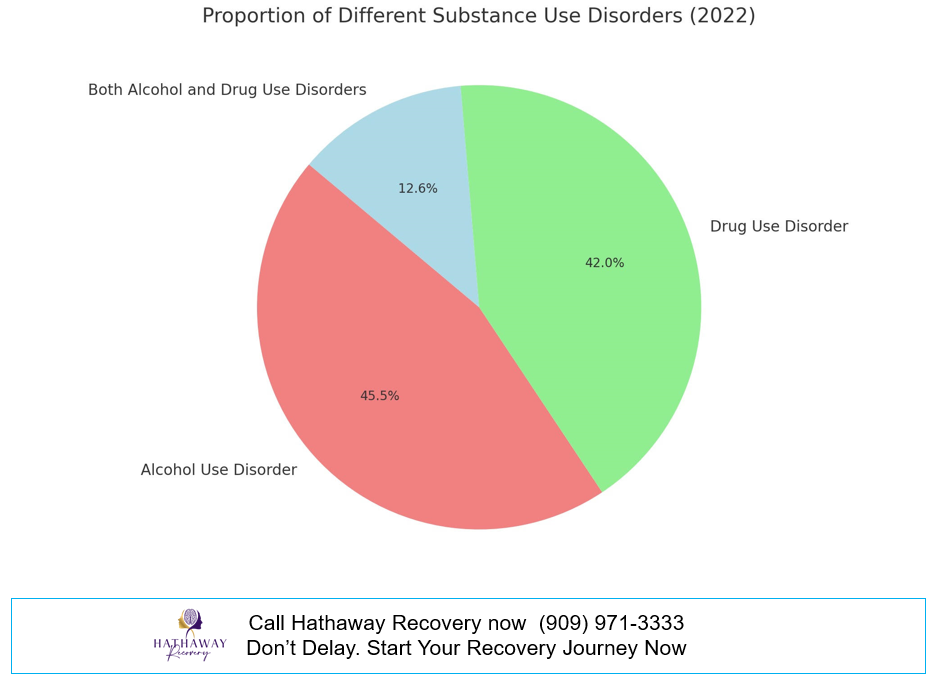
The chart is divided into three segments:
1. Alcohol Use Disorder: The largest segment, comprising 45.5% of the total, shows that alcohol use disorder is the most prevalent type of substance use disorder.
2. Drug Use Disorder: Representing 42.0% of the total, this segment indicates a significant portion of individuals struggling with drug use disorders.
3. Both Alcohol and Drug Use Disorders: The smallest segment at 12.6%, this portion of the chart reflects those who suffer from both alcohol and drug use disorders simultaneously.
The chart effectively highlights that alcohol use disorder is slightly more common than drug use disorder, and a notable percentage of individuals are affected by both. This visual underscores the widespread nature of these issues and the importance of addressing both types of substance use disorders in treatment and prevention efforts.
Don’t Delay. Start Your Recovery Journey Now
For those struggling with addiction, Hathaway Recovery serves as a beacon of hope. Their dedication to restoring and transforming lives is evident in their comprehensive approach to treatment and care. Offering a promise of a new beginning, Hathaway Recovery extends a helping hand to those in need. The Admission Department provides confidential support and can be reached at (909) 971-3333, guiding individuals towards recovery and a transformative journey to a healthier, more fulfilling life.
Hathaway Recovery’s integration of personalized care with an understanding of social determinants of health represents the future of effective addiction treatment. This holistic approach addresses not only the clinical aspects of addiction but also the environmental and personal factors that influence each individual’s path to recovery. By combining these elements, addiction treatment becomes more than a medical intervention; it becomes a journey toward personal empowerment and a fresh start.




